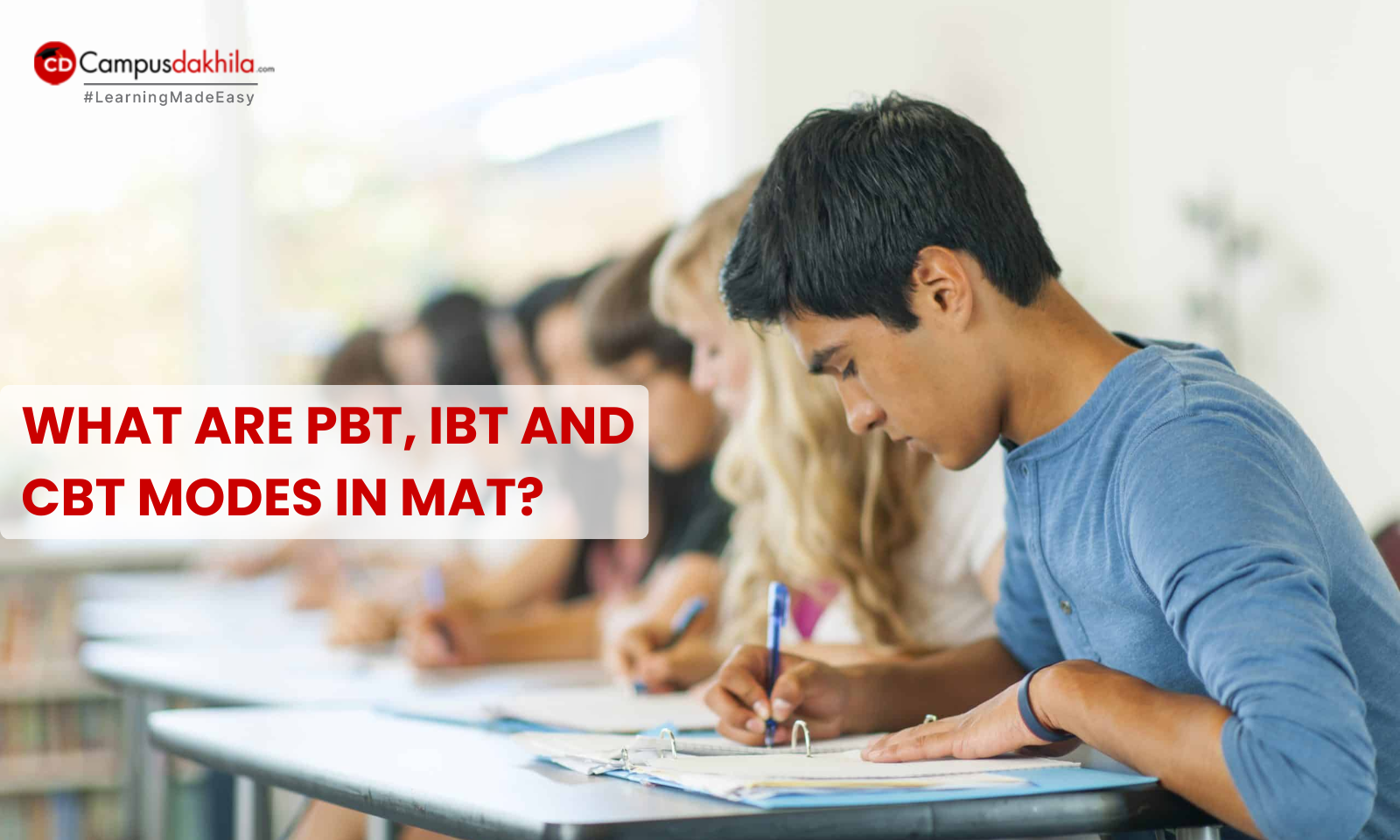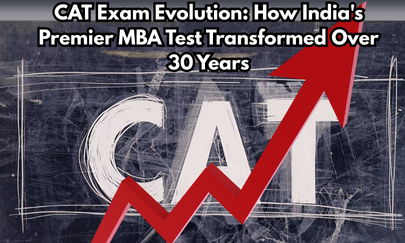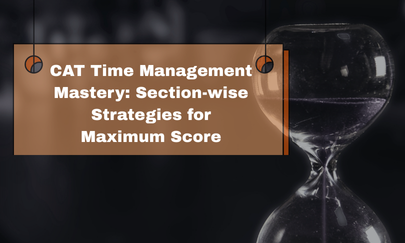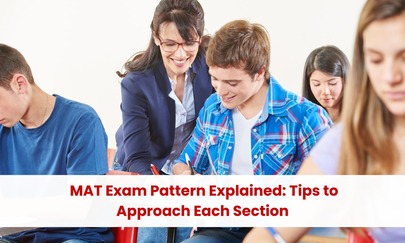
You've probably heard of the Management Aptitude Test (MAT) if you're considering enrolling in an MBA program or other management courses in India. The MAT, a popular entrance exam administered by the All India Management Association (AIMA), aids students in gaining admission to a number of prestigious business schools across the nation. One of the cool things about MAT is how flexible it is, letting candidates choose to take the test in three different ways:
PBT (Paper-Based Test),
CBT (Computer-Based Test), and
IBT (Internet-Based Test).
In this complete blog, we'll explore what each of these test modes entails, how they differ from one another, and which one might be the best fit for you.
1. Understanding the MAT Exam
Before getting into the details of the various modes, let’s first figure out what the MAT exam actually is. The MAT is an entrance exam that takes place at the national level. It evaluates candidates' abilities in different areas, including language comprehension, math skills, data analysis, intelligence, and critical reasoning.
The test is conducted four times a year, typically in February, May, September, and December.
MAT scores are accepted by over 600 B-schools in India, making it a popular choice for MBA aspirants. The exam consists of 150 multiple-choice questions (MCQs), divided into five sections:
- Language Comprehension
- Mathematical Skills
- Data Analysis and Sufficiency
- Intelligence and Critical Reasoning
- Economic and Business Environment
Each section has 30 questions, and the total duration of the exam is 120 minutes (2 hours).
Now that we have an overview of the MAT exam, let’s delve into the details of the different test modes.
2. What is PBT (Paper-Based Test)?
The Paper-Based Test (PBT) is the traditional format of the MAT exam. In this mode, candidates take the test using pen and paper at a designated exam center.
Key Features of PBT Mode:
- Offline Format: The exam is conducted in a physical test center, where candidates receive a question booklet and an OMR (Optical Mark Recognition) sheet.
- Answering Mechanism: Candidates mark their answers by shading the correct option on the OMR sheet.
- Exam Environment: This mode is ideal for candidates who are more comfortable with the traditional exam setup and prefer working with pen and paper.
- Limited Flexibility: The PBT mode is conducted on a specific date and time, and candidates need to be physically present at the assigned center.
Advantages of PBT Mode:
- Suitable for candidates who are not comfortable using computers.
- Ideal for those who find it easier to concentrate in a physical exam hall environment.
- Allows for easy navigation between questions since candidates can flip through the pages of the question booklet.
Disadvantages of PBT Mode:
- Requires travel to the exam center, which may not be convenient for everyone, especially those in remote areas.
- Risk of errors while marking answers on the OMR sheet.
- Limited flexibility in terms of exam scheduling.
3. What is CBT (Computer-Based Test)?
The Computer-Based Test (CBT) is a more modern approach, where candidates take the test on a computer at a designated test center. This mode has gained popularity in recent years due to its efficiency and speed.
Key Features of CBT Mode:
- Online Format: The exam is conducted on a computer at an authorized test center.
- Answering Mechanism: Candidates select their answers by clicking on the appropriate options using a mouse.
- Digital Interface: The exam software allows for easy navigation between questions and sections.
- Time-Saving: The automatic submission of answers ensures that there are no delays in processing the results.
Advantages of CBT Mode:
- No manual filling of OMR sheets, reducing the risk of marking errors.
- Real-time submission of answers ensures quicker processing and results.
- Easy to navigate between questions using the computer interface.
Disadvantages of CBT Mode:
- Requires familiarity with computers and basic typing skills.
- Technical glitches or internet connectivity issues at the test center can disrupt the exam.
- Limited test center availability may pose a challenge in remote locations.
4. What is IBT (Internet-Based Test)?
Introduced during the COVID-19 pandemic, the Internet-Based Test (IBT) mode offers the highest level of flexibility. This mode allows candidates to take the MAT exam from the comfort of their homes using their own computer or laptop.
Key Features of IBT Mode:
- Remote Format: Candidates can take the exam online from their home or any location of their choice.
- Proctoring: To maintain the integrity of the exam, AIMA employs remote proctoring, where candidates are monitored via their device's webcam and microphone.
- Flexibility: Candidates can choose from multiple available slots, making it easier to schedule the test according to their convenience.
Advantages of IBT Mode:
- No need to travel to a test center, making it ideal for candidates in remote areas or those with mobility issues.
- Flexible scheduling with multiple slots available over several days.
- Convenient for candidates who are comfortable with technology and prefer taking exams in a familiar environment.
Disadvantages of IBT Mode:
- Requires a stable internet connection and a compatible device (laptop/desktop with webcam).
- Susceptible to technical issues like internet disconnections, power outages, or software crashes.
- Candidates need to ensure a distraction-free environment at home, which may not always be possible.
5. Comparing PBT, CBT, and IBT: Which One is Right for You?
Choosing the right mode for the MAT exam depends on your personal preferences, comfort with technology, and logistical considerations. Here’s a quick comparison:
|
Feature |
PBT |
CBT |
IBT |
|
Format |
Pen and paper |
Computer-based |
Internet-based |
|
Location |
Exam center |
Exam center |
Home/remote location |
|
Flexibility |
Fixed date |
Fixed date |
Multiple slots |
|
Technical Skills Needed |
None |
Basic computer skills |
High |
|
Proctoring |
Physical supervision |
Physical supervision |
Remote proctoring |
|
Risk of Technical Issues |
Low |
Moderate |
High |
Who Should Choose PBT?
- Candidates who prefer a traditional exam setup and are not comfortable with technology.
- Those who are more comfortable using pen and paper.
Who Should Choose CBT?
- Candidates who are comfortable using computers and can easily adapt to a digital test environment.
- Those who prefer taking the test at an exam center with controlled conditions.
Who Should Choose IBT?
- Candidates who prefer the convenience of taking the exam from home.
- Those who have a stable internet connection and can ensure a distraction-free environment.
6. Final Thoughts
Choosing between PBT, CBT, and IBT really comes down to what feels best for you, how convenient it is, and how comfortable you are with technology. PBT continues to be a favorite for those who enjoy the classic approach, while CBT and IBT are becoming more popular because of their flexibility and convenience, particularly in today's digital world.
As a candidate, it's important to consider the advantages and disadvantages of each option before making your choice. No matter which mode you pick, just make sure you're ready and practice a lot to boost your chances of doing great!
Good luck with your MAT exam journey!
Any question in your mind?
Connect to our counsellor: 8826807515












